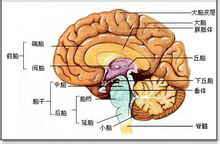The brain is the brain and the diencephalon. In medical and anatomical terms, the term brain is often used to refer to the telencephalon.
The telencephalon has both left and right hemispheres (telencephalon). Separating the two hemispheres is a gully called the mediastinum, which is completely separated from each other except that the cerebrum is connected to the transparent septum. The surface of the hemisphere is covered with sulci, and the elongated part between the sulci is called gyri. The sulci are not formed at random as the brain grows; they are perfectly regular where they appear (their depth and curvature vary slightly from person to person). "Each sulcus is anatomically known as Nomina Anatomica. The morphology of sulci and gyri is basically symmetrical in the left and right hemispheres, which is an important marker for the lobulation and localization of the brain. The lateral sulcus, an important lateral sulcus, rises below the hemisphere, rows backward and above, and reaches the outer side. The central sulcus rises just behind the green midpoint on the upper hemisphere, and slopes downwards and forwards, with the lower end separated by a gyrus from the lateral sulcus, and the upper end extending to the lateral side of the hemisphere. The parietooccipital sulcus (parietooccipital sulcus) is located posteriorly on the lateral side of the hemisphere, from bottom to top. Above the lateral sulcus and before the central sulcus are the frontal lobes; Below the lateral sulcus is the temporal lobe; The occipital lobe is located at the back of the hemisphere, and its anterior boundary is the occipital groove at the inner side. The boundary of the upper lateral surface is the line from the occipital groove to the anterior occipital notch (about 4cm in front of the posterior end of the occipital lobe). The parietal lobe is the part above the lateral sulcus, behind the central sulcus and before the occipital lobe. The insula is triangular-shaped, deep in the lateral sulcus, and is covered by the frontal, parietal, and temporal lobes, which differ from other parts of the brain and are dotted with small, shallow sulci (non-sulci).
The left and right hemispheres of the brain have separate lacunae called lateral ventricles. There are openings between the lateral ventricle and the third ventricle of the diencephalon, and between the cerebellum and the cerebellum and the pons. The choroid plexus in the ventricle produces the fluid of the brain called cerebrospinal fluid. Cerebrospinal fluid circulates between the ventricles and the subarachnoid space.
In the broad sense, the cranial nerves of the brain are the olfactory nerves from the telencephalon and the optic nerves from the diencephalon.
The diencephalon consists of the thalamus and the hypothalamus. Thalamus and cerebral cortex, brainstem, cerebellum, spinal cord and other liaison, responsible for sensory relay, control of movement, etc. The hypothalamus is associated with maintaining physical constancy, controlling the autonomic nervous system, emotions, etc.

